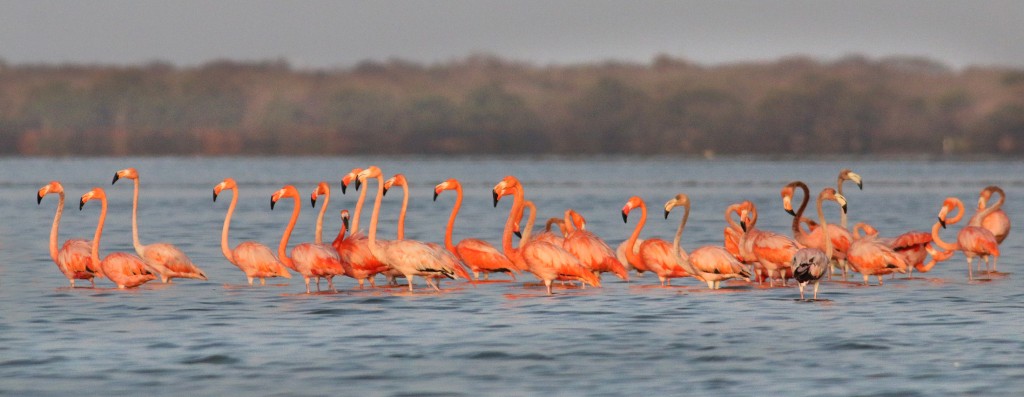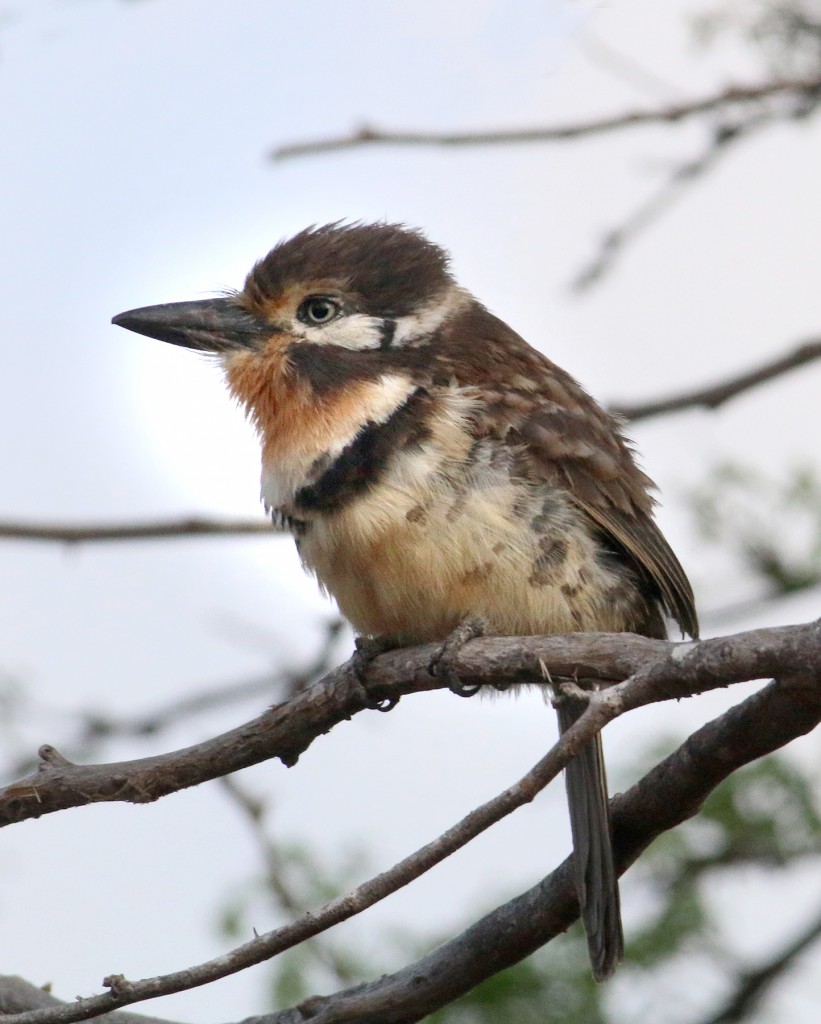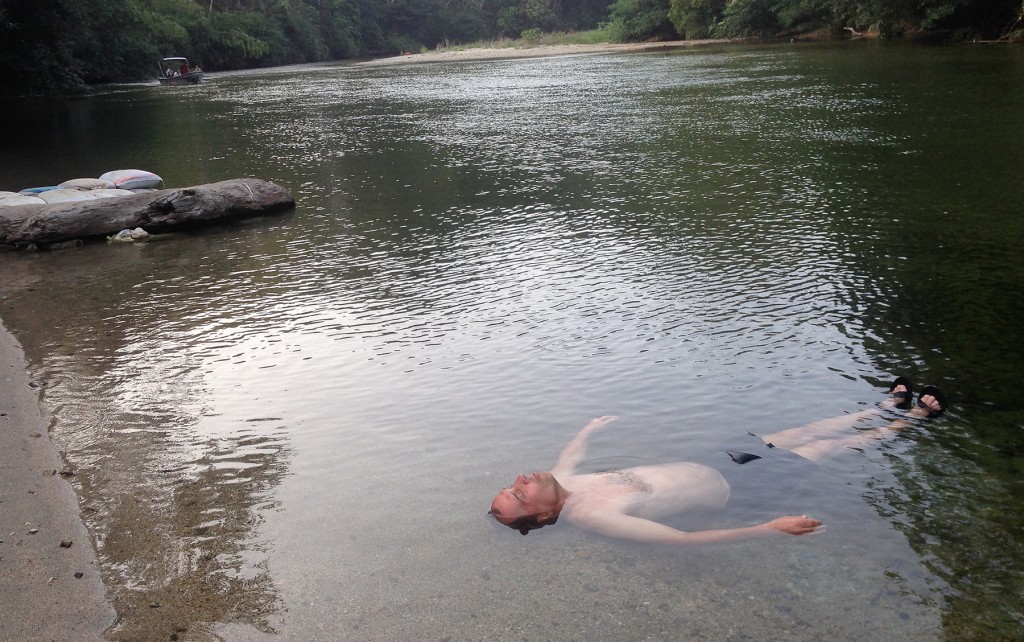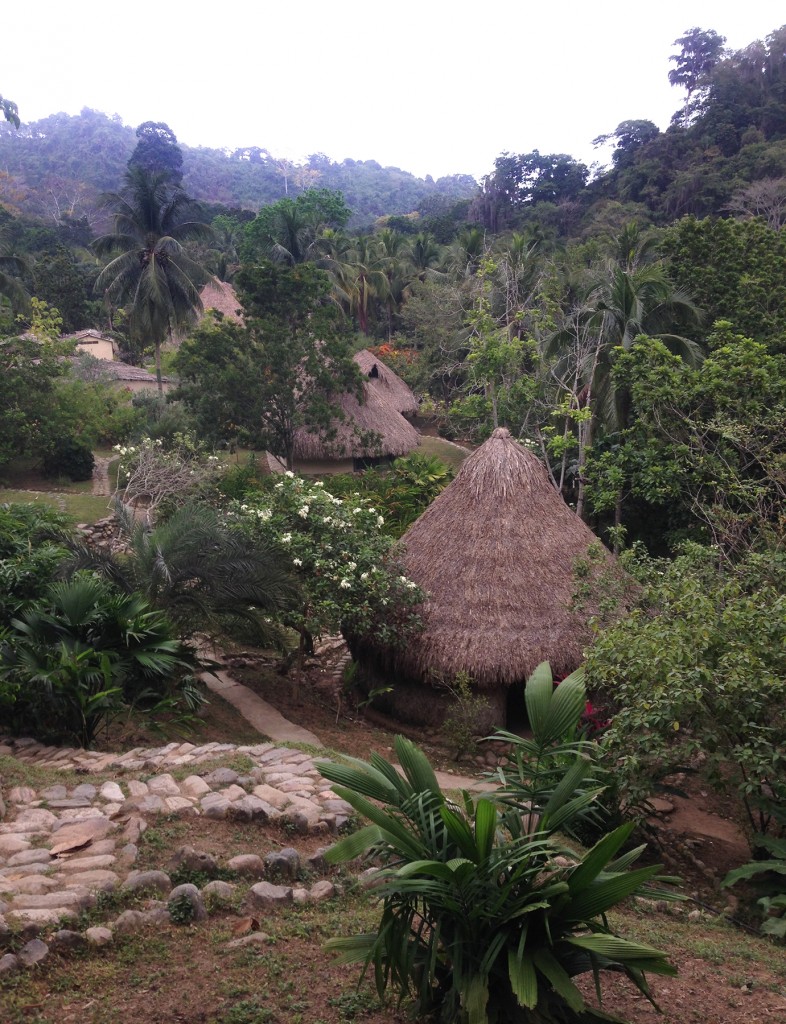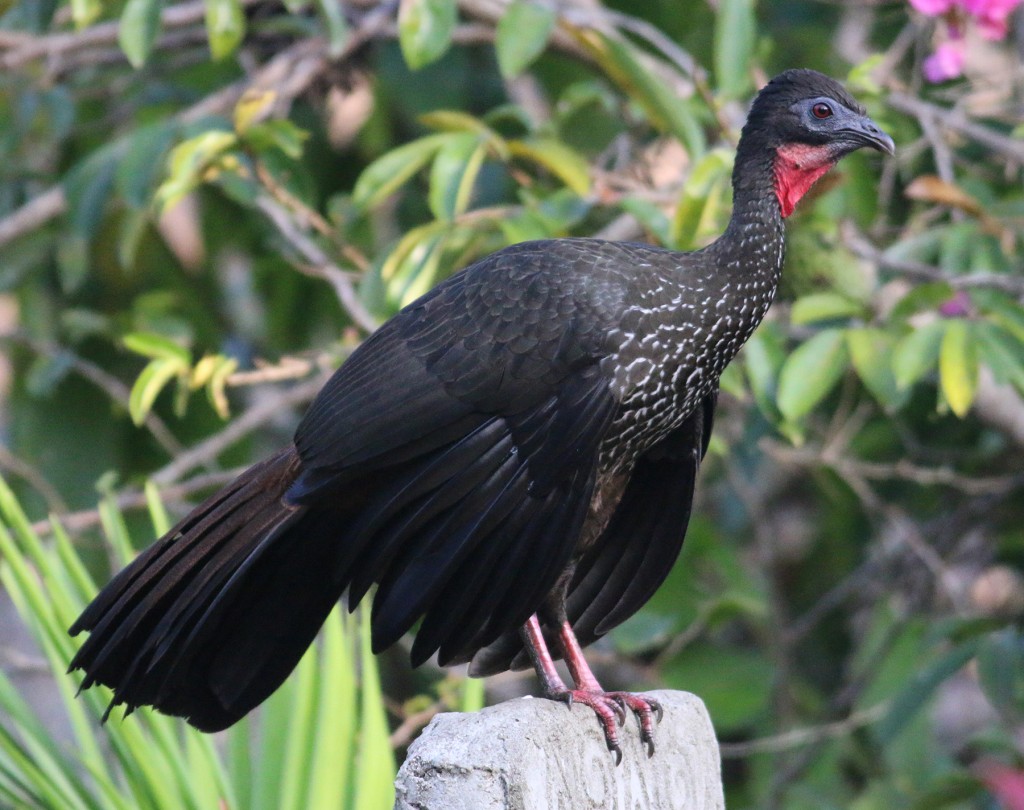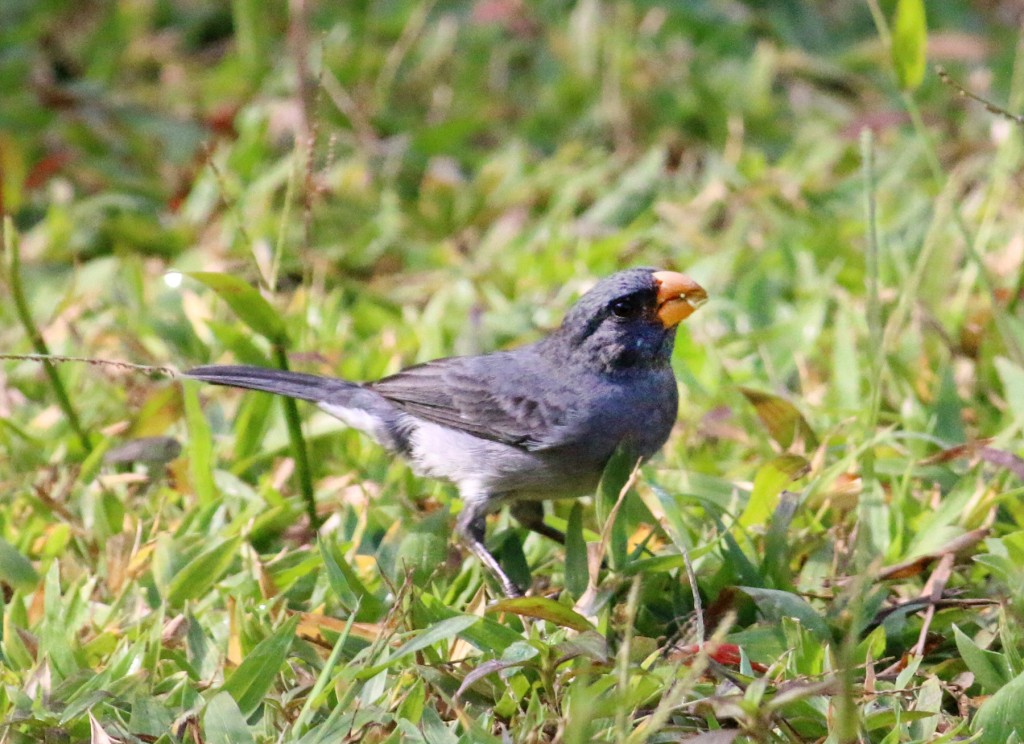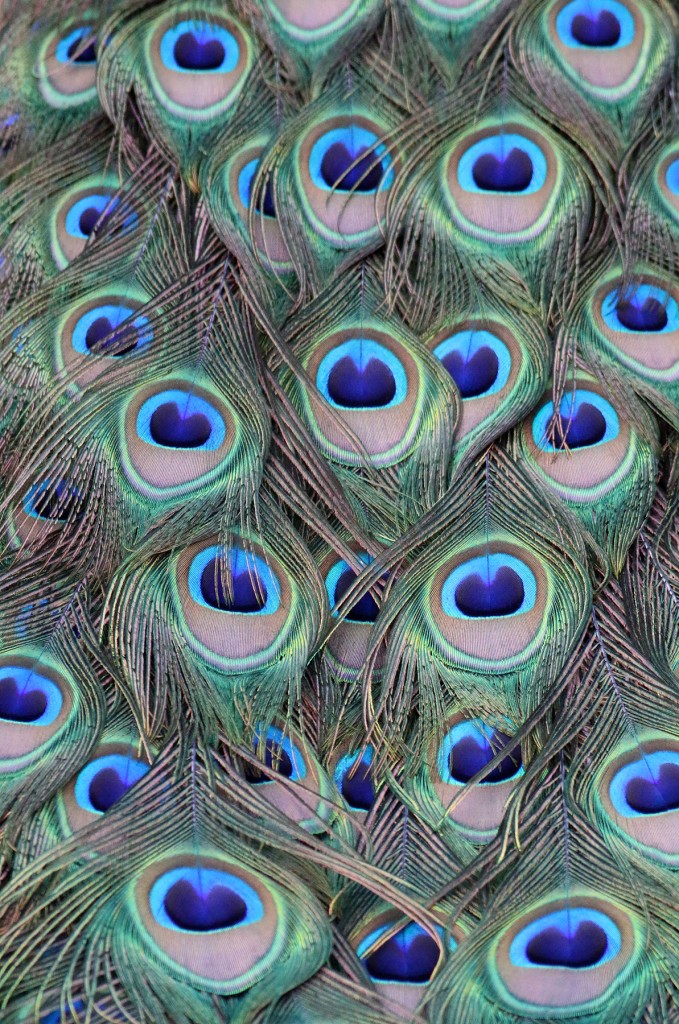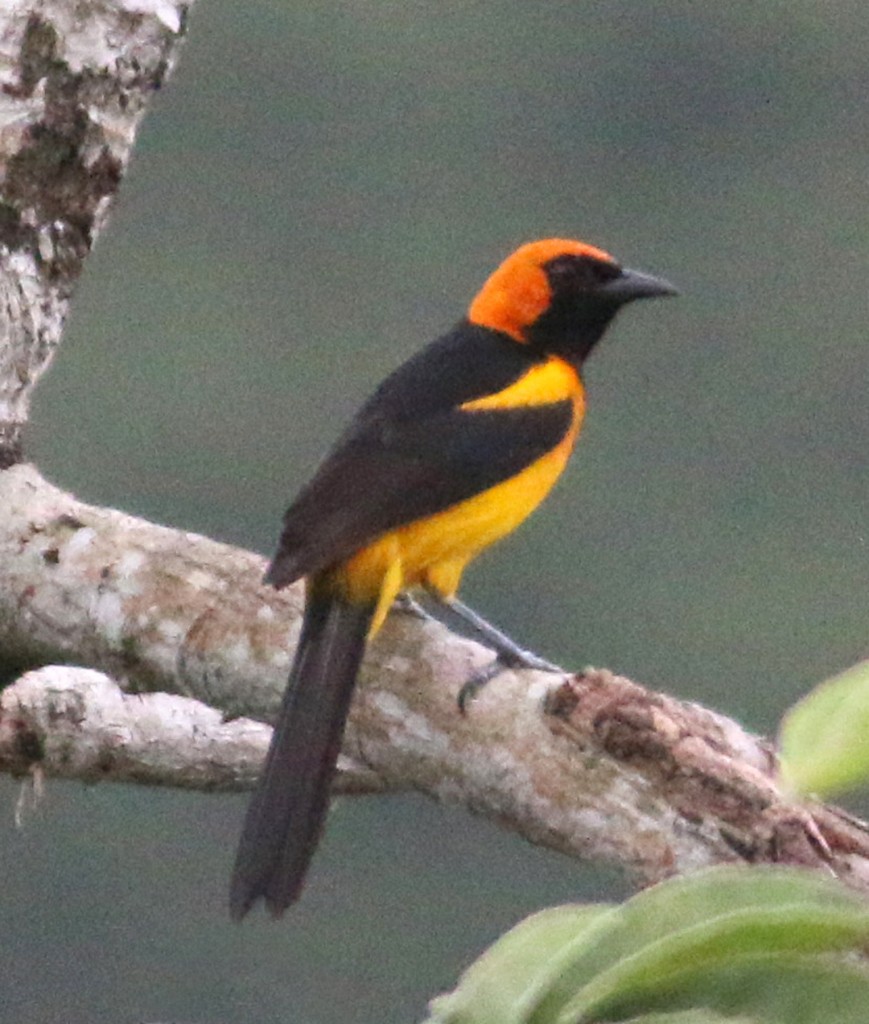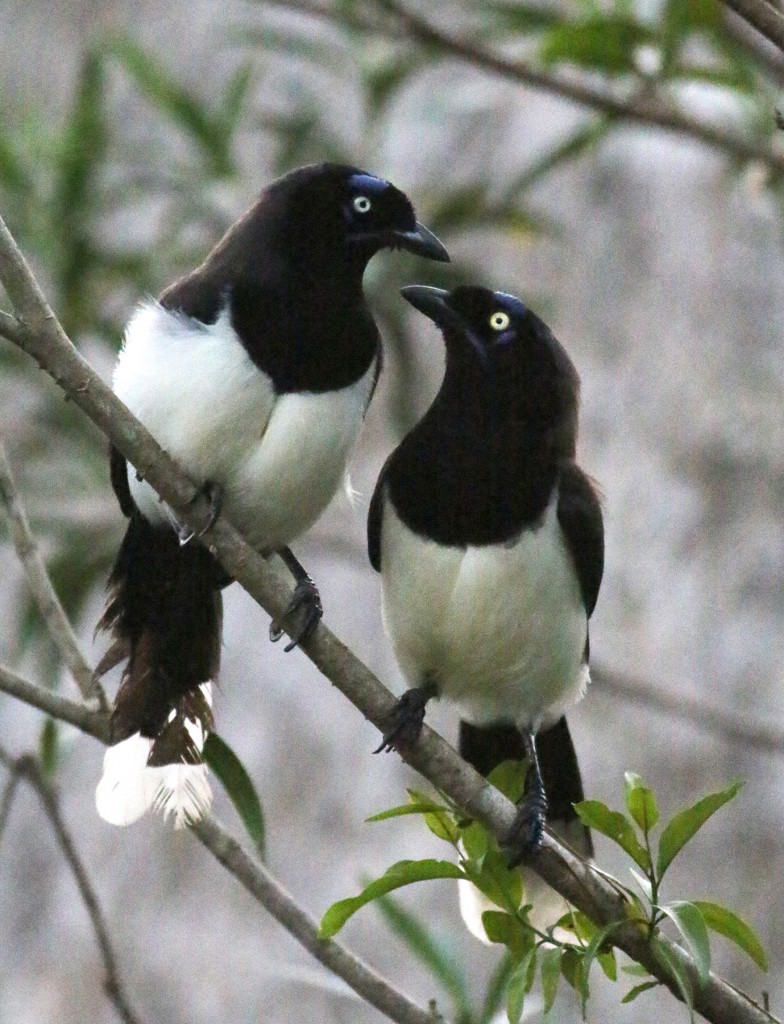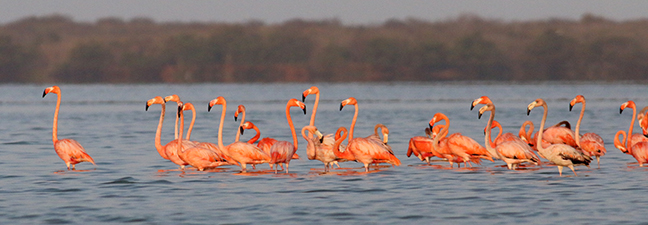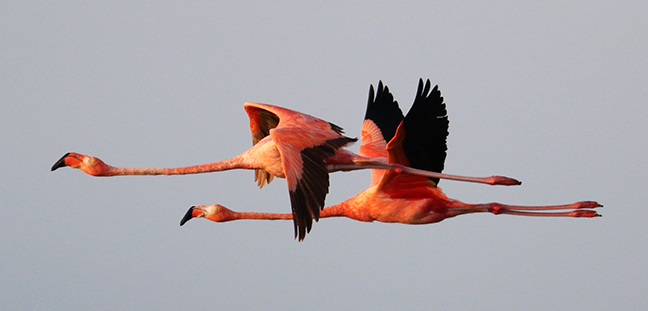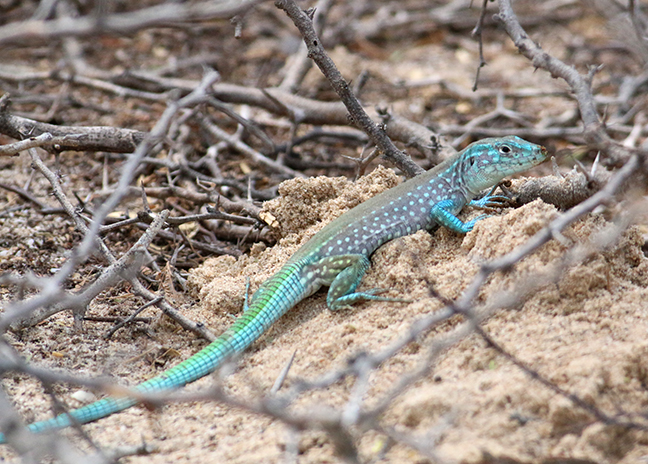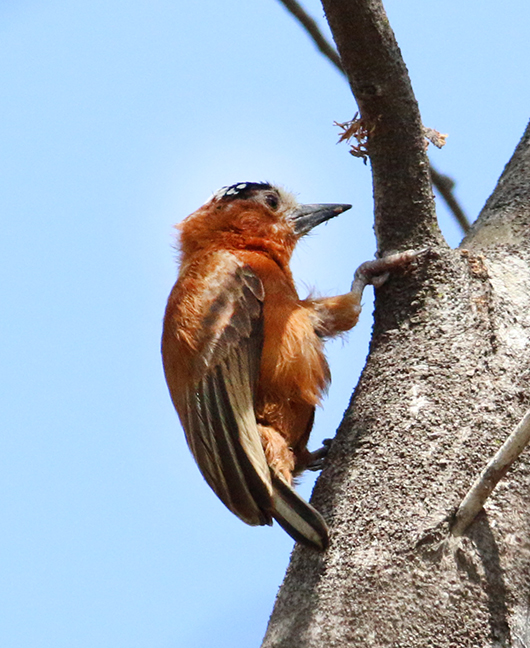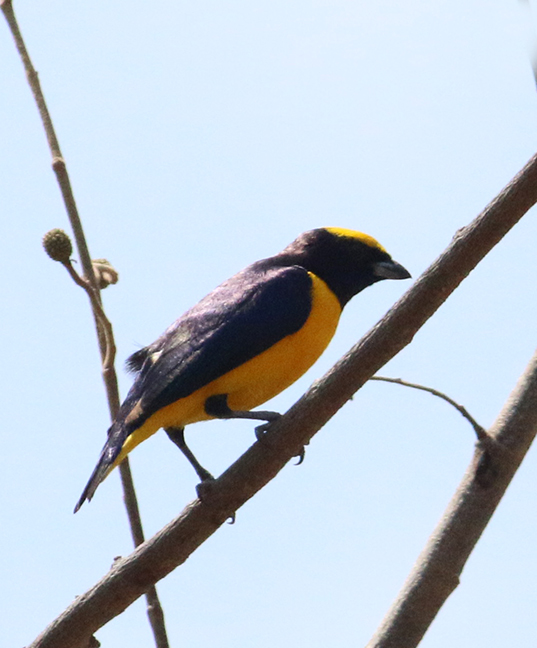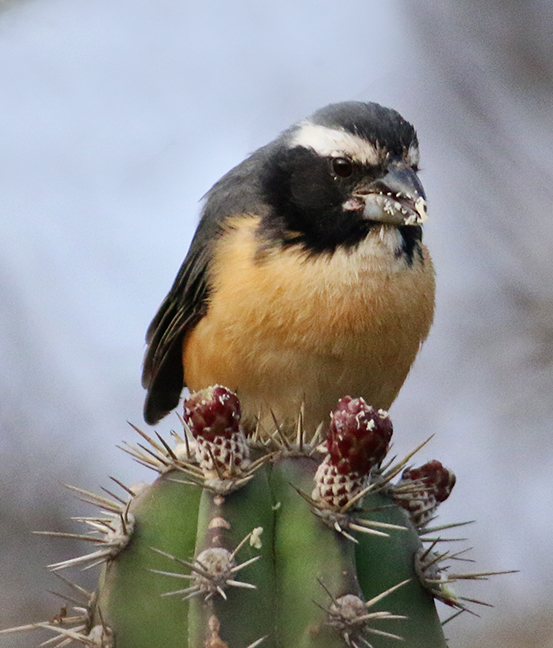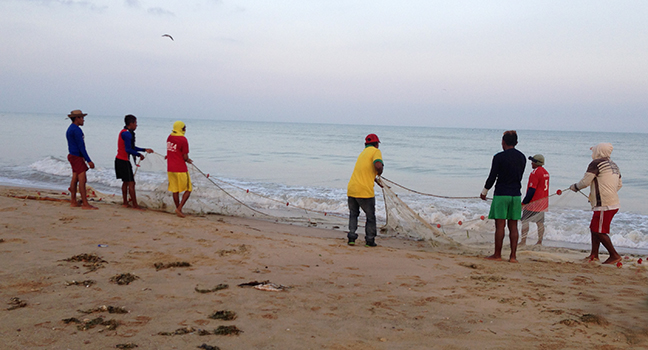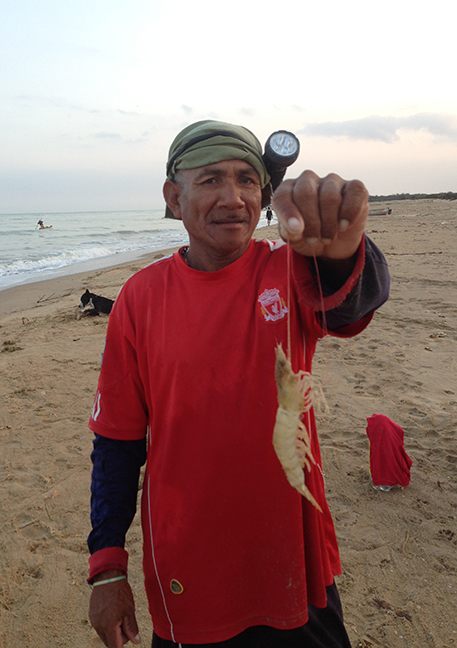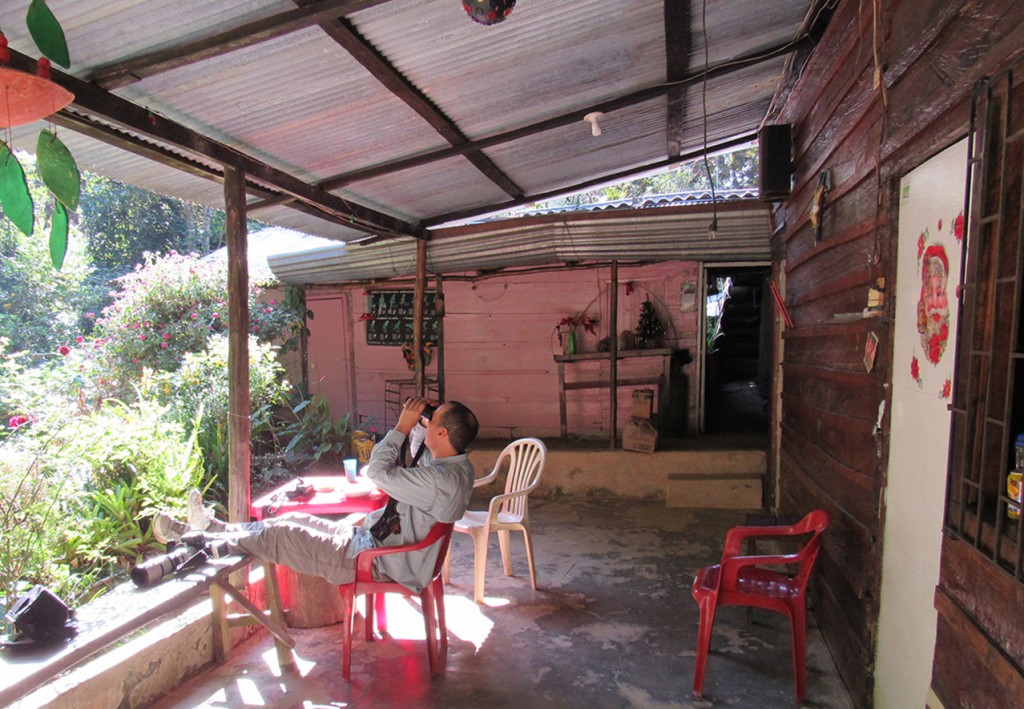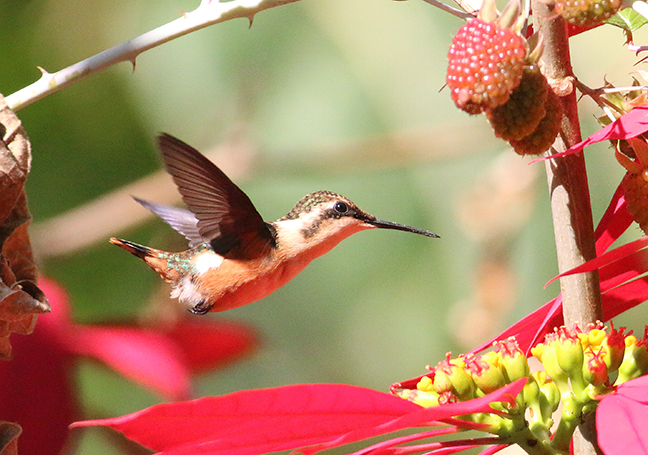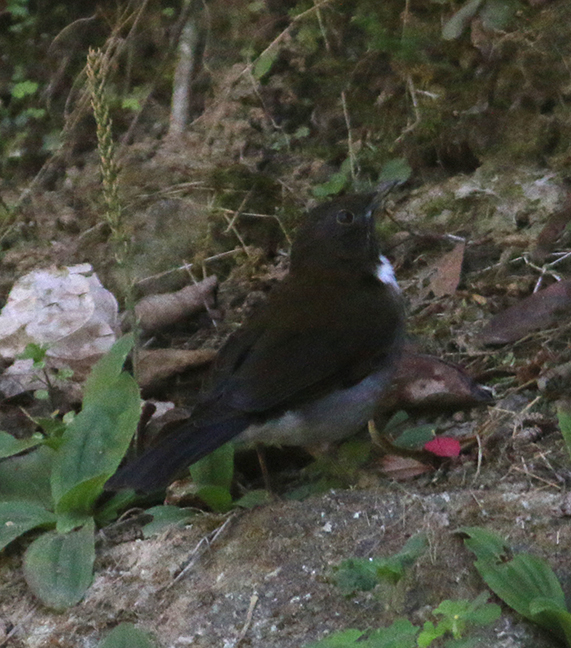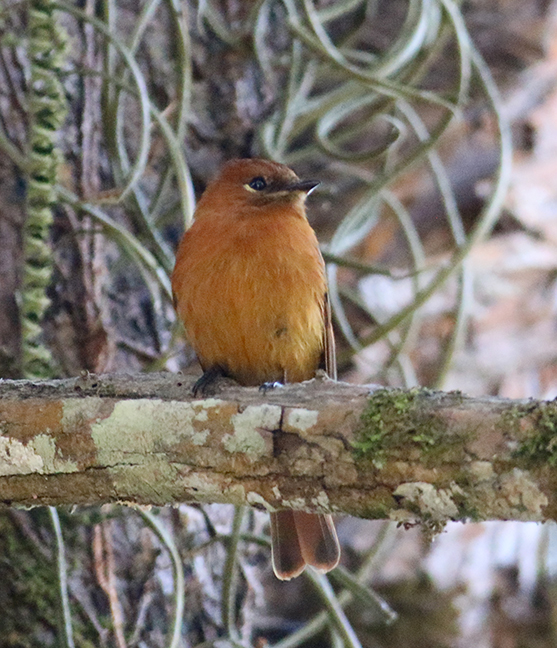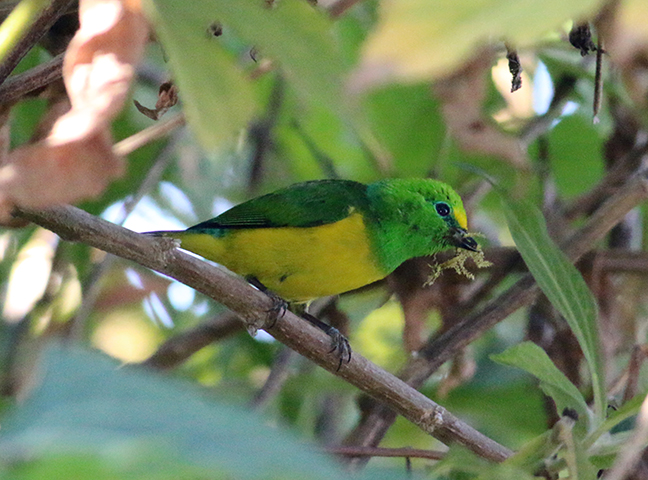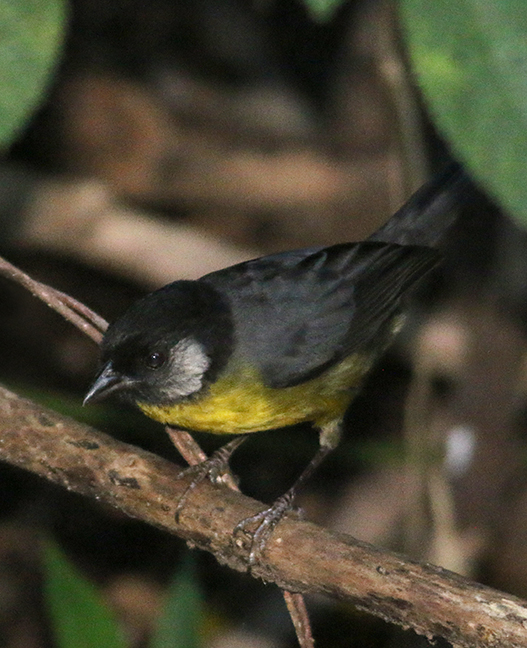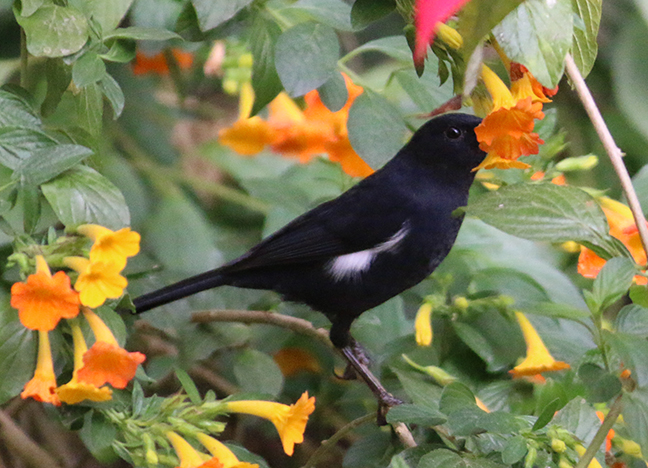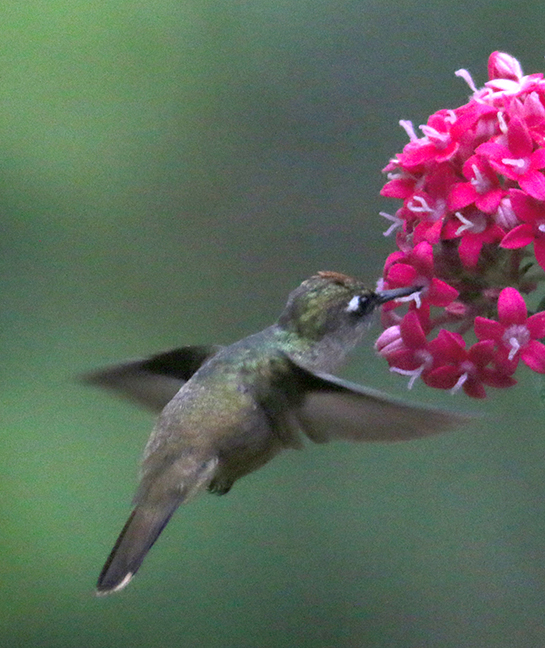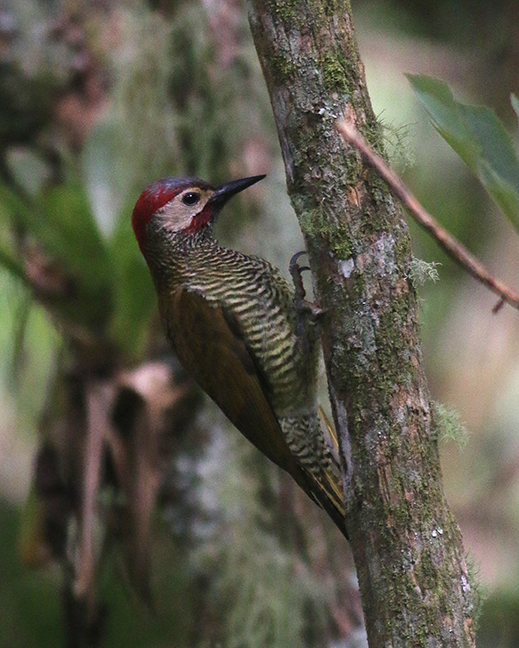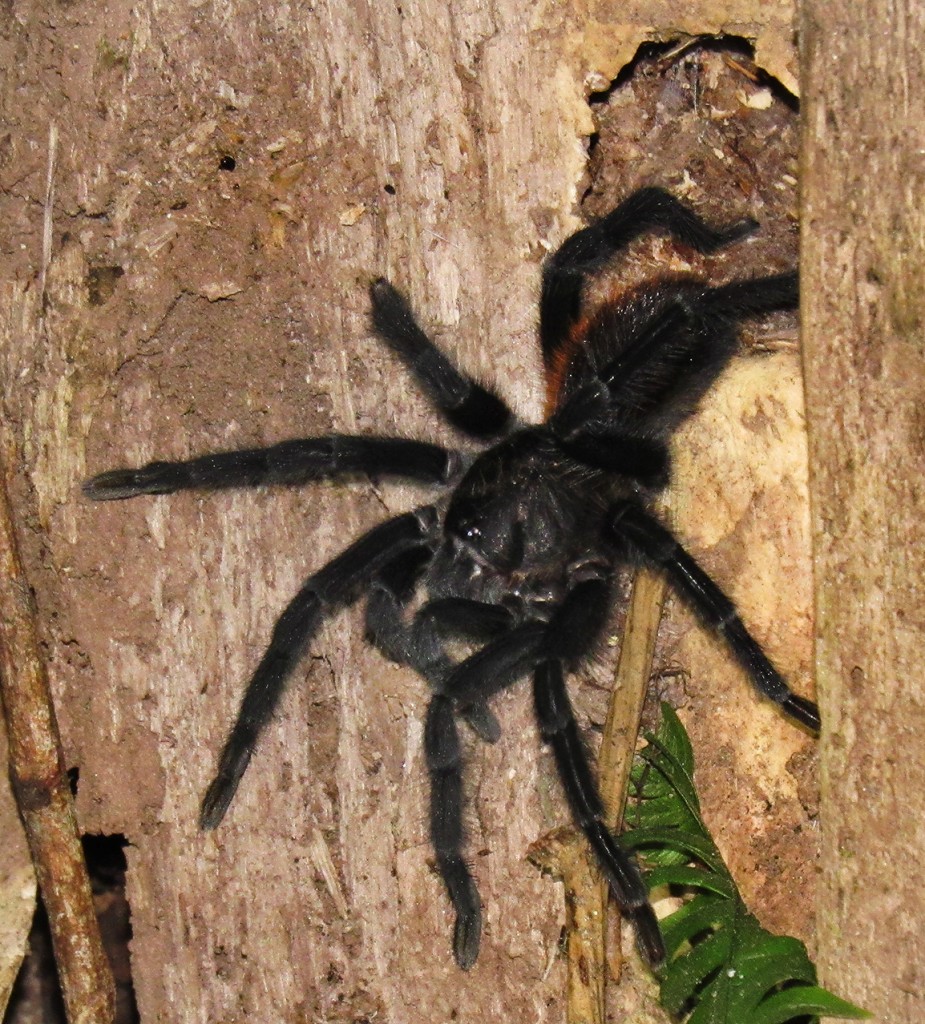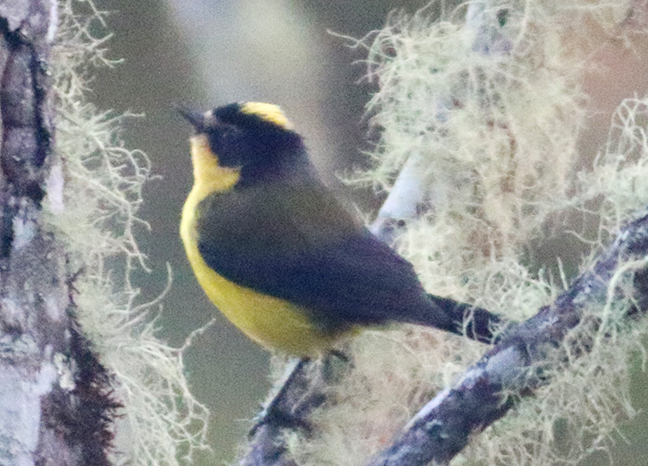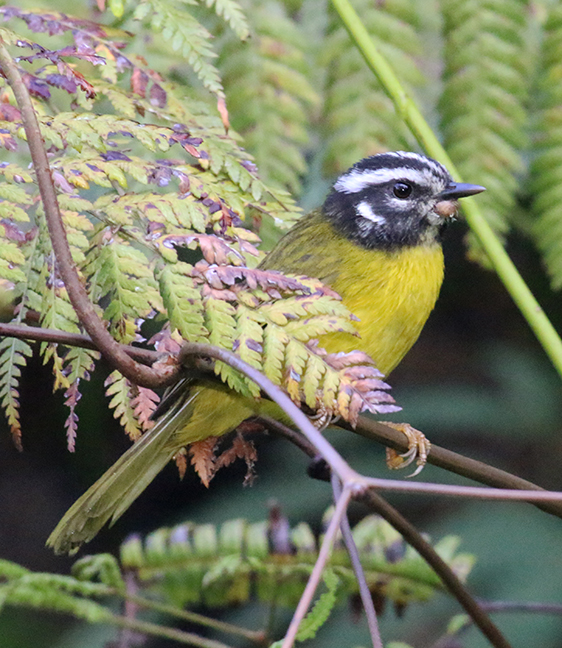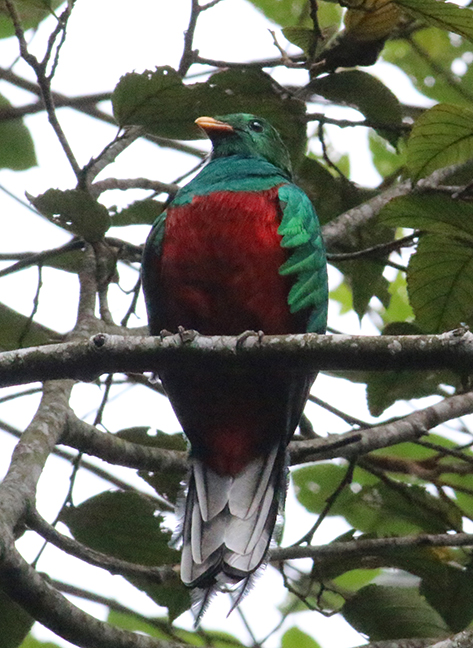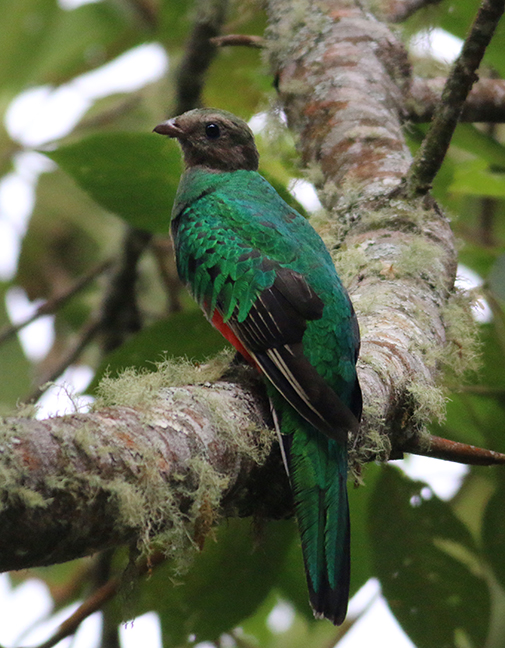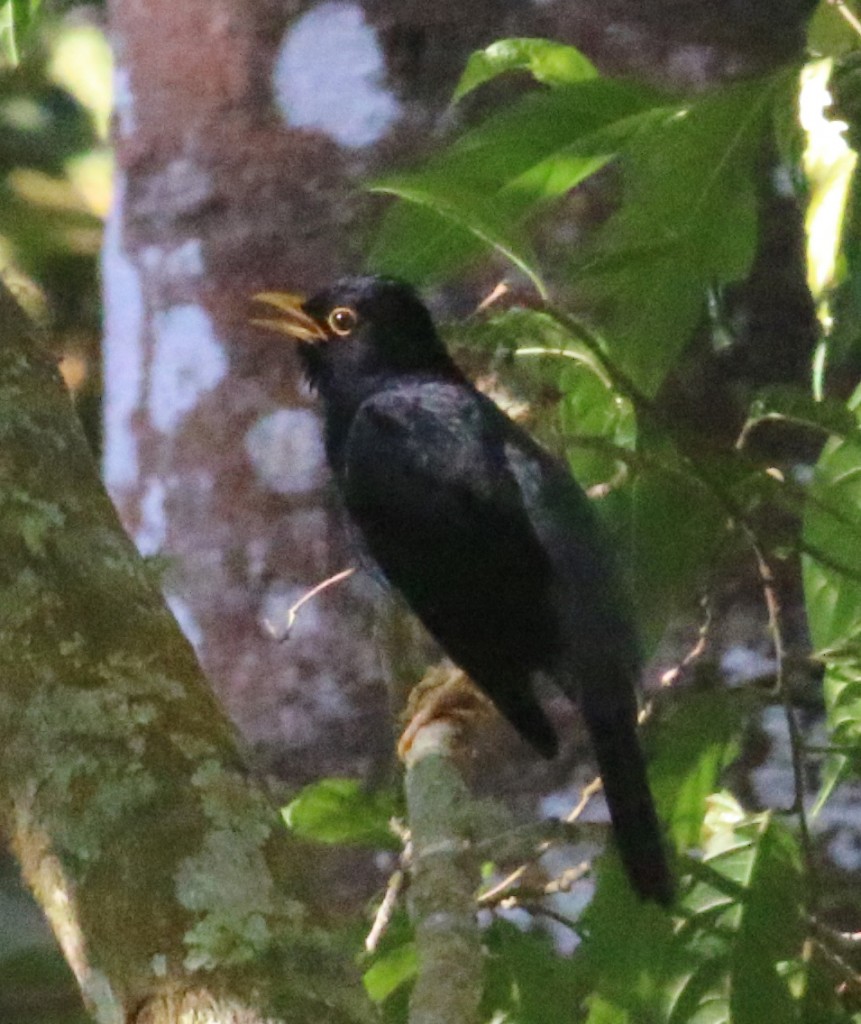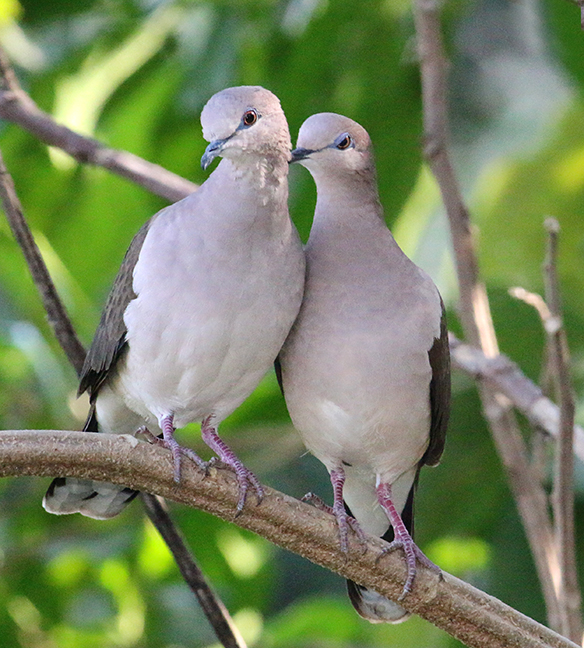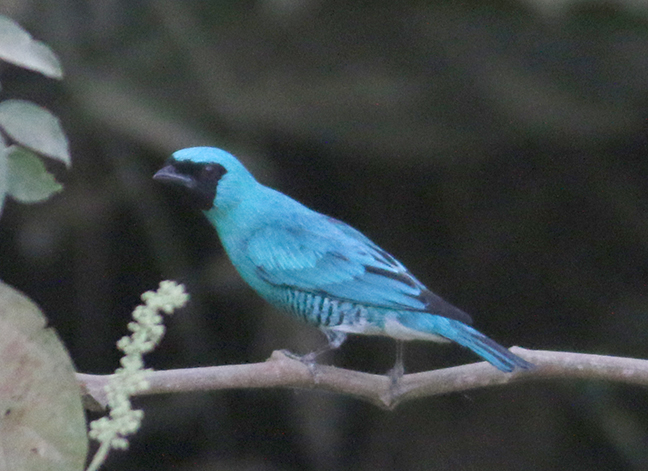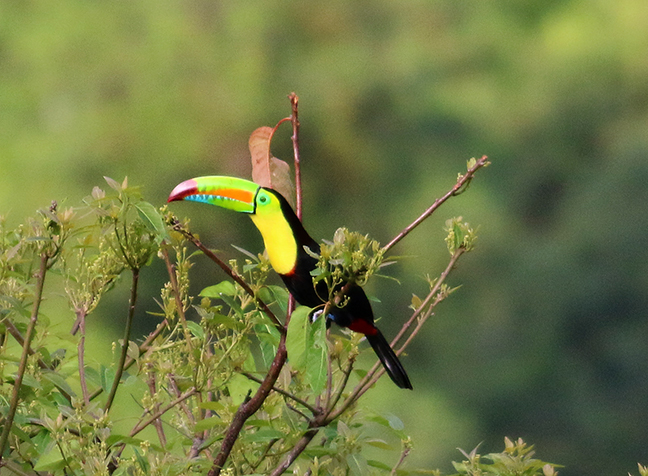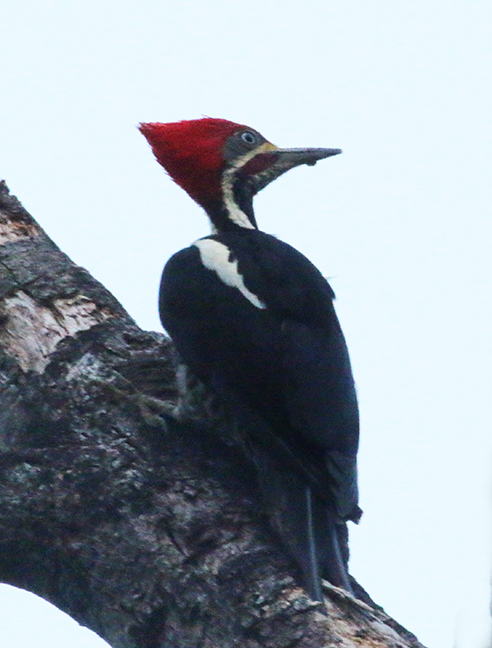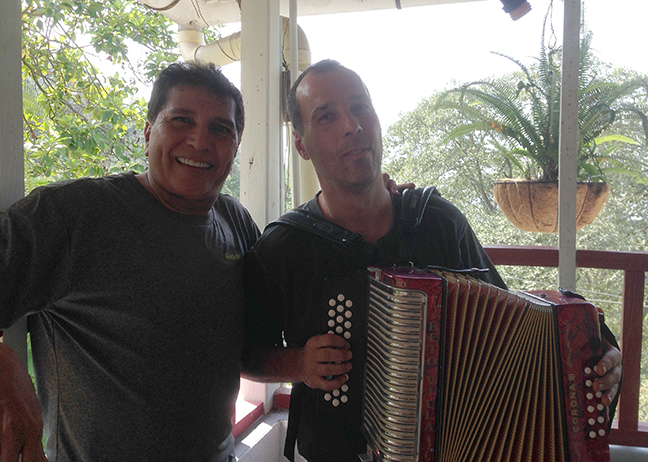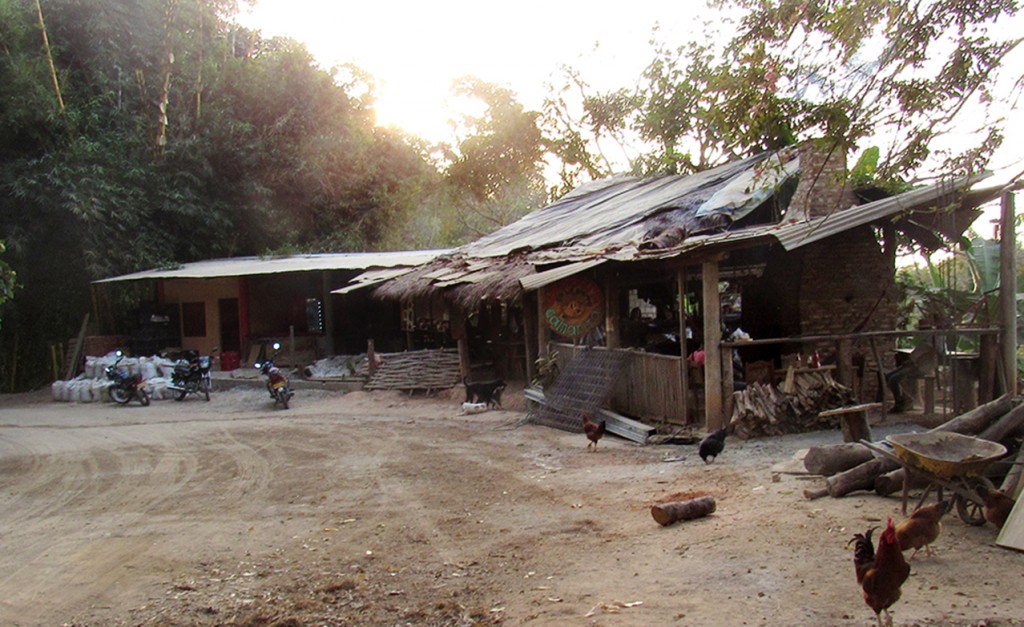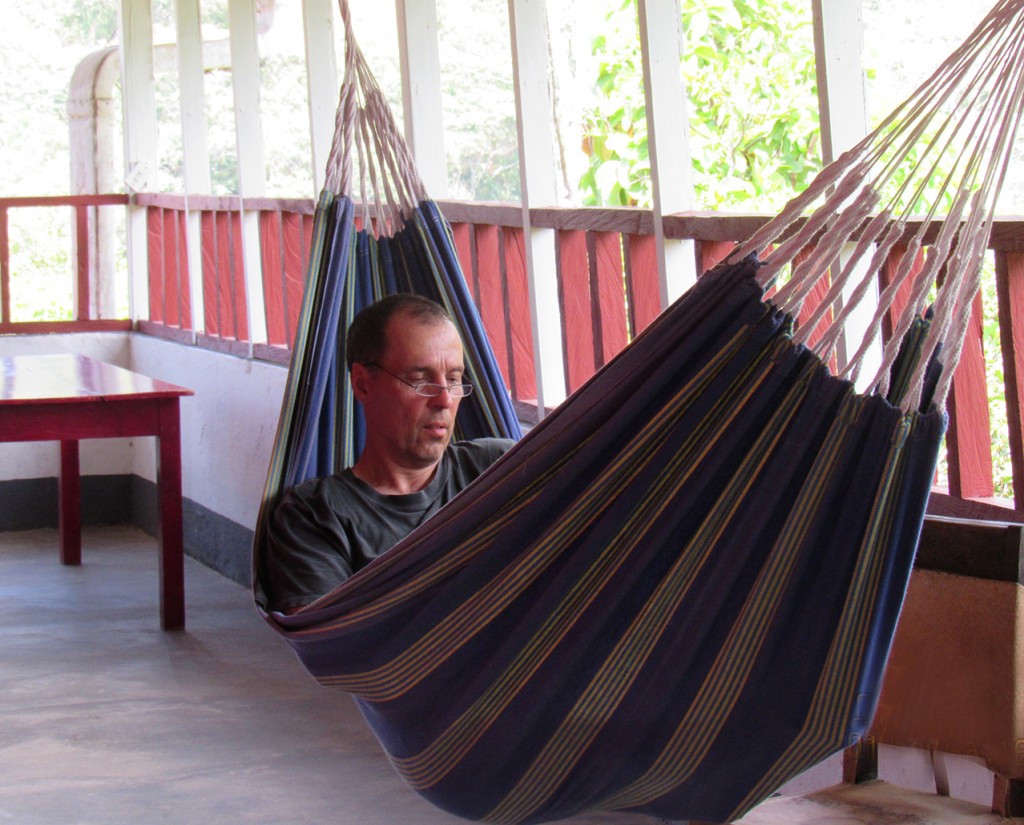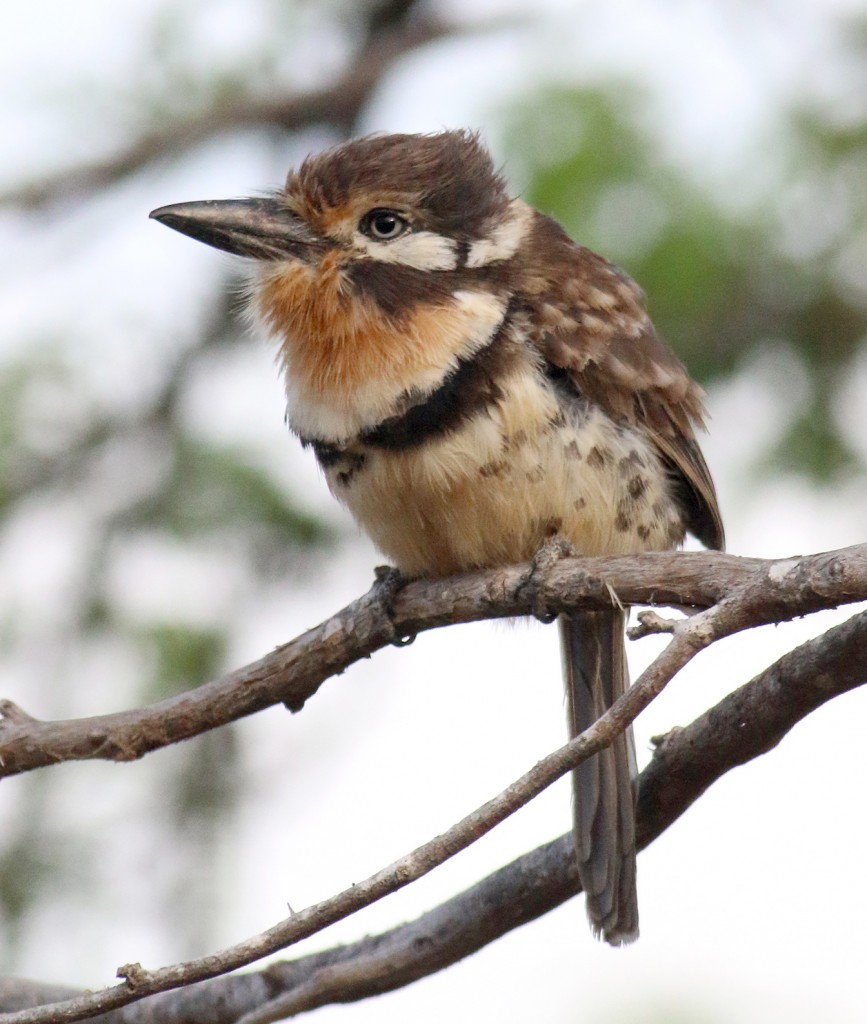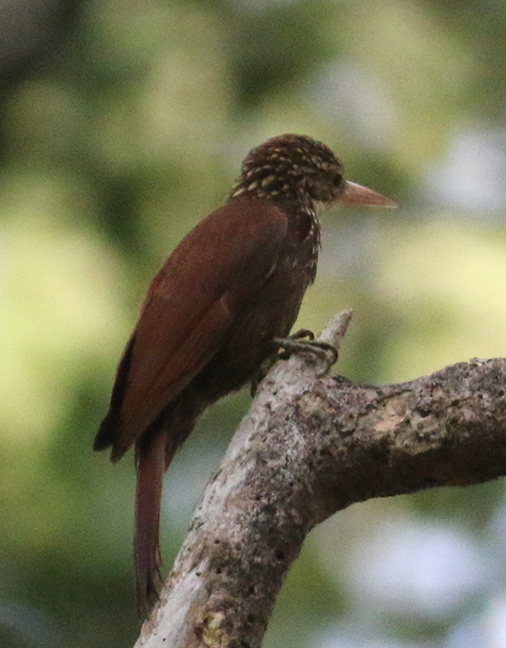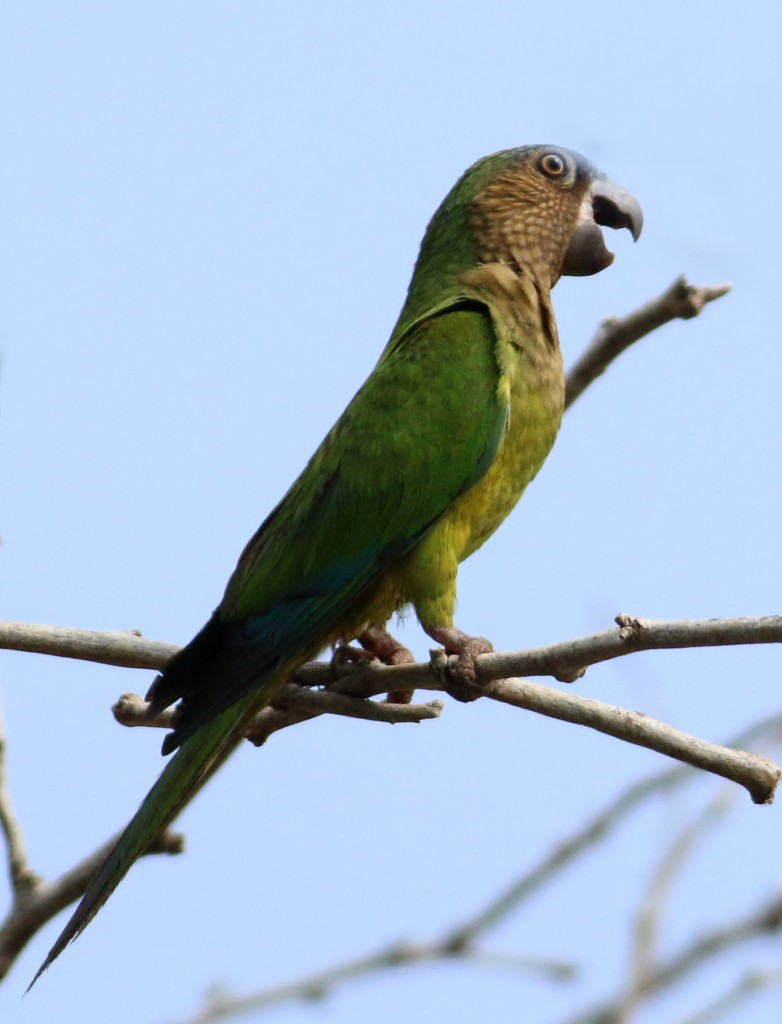Colombia can be an intimidating location for birding. After all, more than 1900 species of birds can be found in this diverse country. Birding tours to Colombia typically spend most of the time exploring at different altitudes in one or more of the central Andean mountain ranges and in the inter-Andean valleys. These same tours often include a ~6-7 day ‘Santa Marta extension’ to the Santa Marta region near the north coast. For my style of birding, a 6-7 day ‘extension’ constitutes a complete trip, so my friend Pete and I spent 12 days exploring the Santa Marta highlands and the desert scrub of the nearby and coastal Guajira region, partly guided, and partly on our own. Blog entries describing this trip start here. The photos in this quiz constitute many of the common birds of the region, combined with some of the desirable regional endemics and near-endemics. If you are planning a trip to Santa Marta, this quiz would be a good introduction to the birds that you will see there. Take a bird tour of the Santa Marta region by clicking here.
After a very productive two days in Santuario de Los Flamencos, we spent the next two days at Taironaka, an ecolodge located on the Don Diego River ~15 miles east of Tayrona National Park. To get to the central lodge grounds, there is an option to either walk an 800 meter-long trail (not a simple matter with with our over-packed luggage), or to take a short ~10-15 minute motorized boat trip upriver. That decision was easy. The property here is very nice, with several hundred yards of river frontage and multiple cabins that likely can accommodate a total of ~70 guests. By far this was the most extensive and most comfortable lodging that we used on the entire trip. And that was no accident. I figured that by this time we’d be pretty exhausted and need some down time. And relax we did. Our days here typically started with an early morning walk, a relaxing breakfast, another short walk, and by noon we were ready for some river time. This meant jumping into the river and floating down from the upper end of the property to the lower end or just relaxing in the shallows. It’s amazing what an effect cool water and effortless floating has on the psyche. It helps when an occasional Amazon or Ringed Kingfisher calls from the riverbank. Let’s call it river therapy.
Taironaka isn’t exactly a high-level birding destination, although each day at lunch we were joined by a small guided group that had birded the ~800 yds from the road to the dining area. We had a few good sightings on the grounds and on the trails, but since we were tired and only had a single pair of functioning binoculars, birding was secondary to relaxation here. Nonetheless, we did have great sightings of a Crested Guan that is habituated to the dining area, and on the trails we saw Orange-crowned Oriole, Gray Seedeater, and at least five Rufous-tailed Jacamars on a single walk. And yes, it was hard to ignore the peacocks that roam the grounds.
After our enjoyable stay in Taironaka, we made the successful transfer to Santa Marta Airport and the short flight into Bogota. We opted for a ~20 hour layover in Bogota to avoid another night of trying to sleep in an airport. We didn’t have any birding plans for the day, as prior attempts at arranging for a guide fizzled out. We found a great B&B called A Bogota on Holiday located 10 minutes from the airport that had free airport pickups. In fact, while driving us to the B&B the owner asked if we had any plans for our day. When we mentioned that we were birders, he said he knew a driver who would take us to a local destination. So within 45 minutes after landing, not only were we checked into a comfortable and pleasant B&B, but we were on our way to our final birding destination, the wetlands of La Florida Park. It was mid-afternoon, so it wasn’t optimal timing, but the pond at La Florida was filled with recognizable species like American Coots, Ruddy Ducks, Black Phoebe, and Common Gallinules, and we picked up our final new species including Spot-flanked Gallinule, Yellow-hooded Blackbird, Subtropical Doradito, Brown-bellied Swallow, and Apolinar’s Wren to end our trip.
THE SUMMARY
This was an interesting trip. I began with trepidation, wondering if our safety was going to be in danger every day from narco traffickers and armed FARC nationalists and anti-American kidnappers. After all, I’ve never been to a location where the US State Department issued strong warnings to travelers. Yet from the day of our arrival, we never had a time when we felt endangered, and the people of Colombia were uniformly open, warm, and friendly. I suspect that there might still be pockets in the south or on the Pacific coast where it might not be wise to travel alone at this point, but there were no problems at all for us alone in the entire Sierra Nevada region. A lasting memory for me is the sharp contrast between all the comforts that we have in the US (and that we take for granted) and the simpler life of the average Colombian citizen. A trip like this is not for all travelers; in fact, most travelers avoid staying at the hostels and fincas, preferring the comfortable birding lodges. For me it was a great learning experience.
As for the birds, well…we ended up with 251 species seen, of which 61 were lifers for me. For a Colombian tour, those are not outstanding numbers, but we were guided for less than half of the trip, we visited only a very small portion of the country, and I spent more time relaxing on this trip than on previous birding vacations. For anybody who is in search of endemics, this is clearly a region worth visiting, with 19-20 true endemics possible on the road from Minca to San Lorenzo Ridge. As with any trip, there were missed species, but does it really matter? Instead of worrying about what we missed, I prefer to focus on what we saw and did; memories of Russet-throated Puffbirds perched a few feet from us, or live accordion music coming from around the corner, or floating down a river, or watching hundreds of American Flamingoes flying toward our boat, or following a Pale-legged Hornero through the brush, or sitting on the tienda porch in the middle of nowhere waiting for an endemic hummingbird to arrive.
It was probably a three-or-four hour drive from Minca to our next major stop at the village of Boca del Camarones, which is located at the junction of the Atlantic Ocean and the Santuario de Los Flamencos in eastern Colombia. This area is very hot and very dry, with dry scrub and cactus dominating the landscape. Because we arrived here at the beginning of February, which is well into the dry season, the dryness was exaggerated, with extensive obviously parched shorelines. In comparison to the cloud forest where we have spent most of this trip, this is completely different habitat, with an accompanying collection of new target species. We arrive in late afternoon, and as we leave Route 90 and its truck traffic behind and head down the local dirt roads, our first stop at a bridge starts turning up new species already, with Bare-eyed Pigeons in the treetops and a covey of Crested Bobwhite scampering into the brush. We drive through the dirtiest village that I’ve encountered, Camarones, with plastic and trash scattered everywhere, but thankfully continue onward and reach our destination for the next two nights, the Remanso del Santuario, just a few hundred yards from the Atlantic Ocean. Remanso is small, with two rooms in a cabina to house visitors.
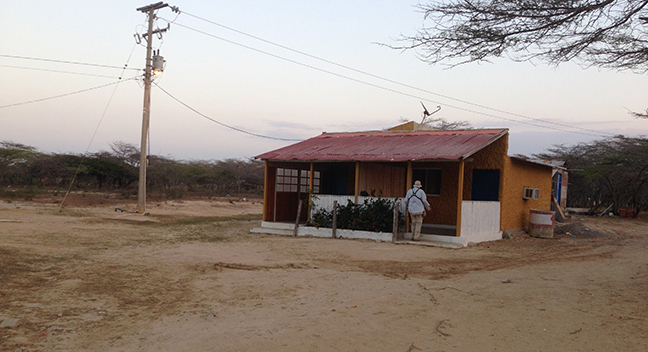
Our cabina for two nights at El Remanso del Santuario. It’s not exactly the Hilton, but it’s as true for birding as it is for real estate; the most important things are location, location, and location.
The much-anticipated highlight of this entire trip for me was the hope of seeing wild American Flamingoes for the first time. I was anticipating maybe seeing a dozen or two if we were lucky, but we did much better than that. One morning we met a local native, Saleem, who along with a partner poled us in their dugout canoe to a distant location within the sanctuary where some of the Flamingoes were congregated. We found a group of perhaps 100 or so and gradually moved closer. Two other large flocks were visible in the distance, but too far to travel there. Remarkably, part of one of those flocks decided to join the flock that we were watching, as we were treated to hundreds of Flamingoes flying past and around our boat. FAN-TAS-TIC!! Saleem estimated seeing 2,500 Flamingoes in the refuge the day before; on our trip I’d imagine that more than 1,000 were present. Scattered in between were occasional Scarlet Ibis and Roseate Spoonbills, along with more familiar herons and egrets. What a great morning. And isn’t it nice to exceed your expectations?
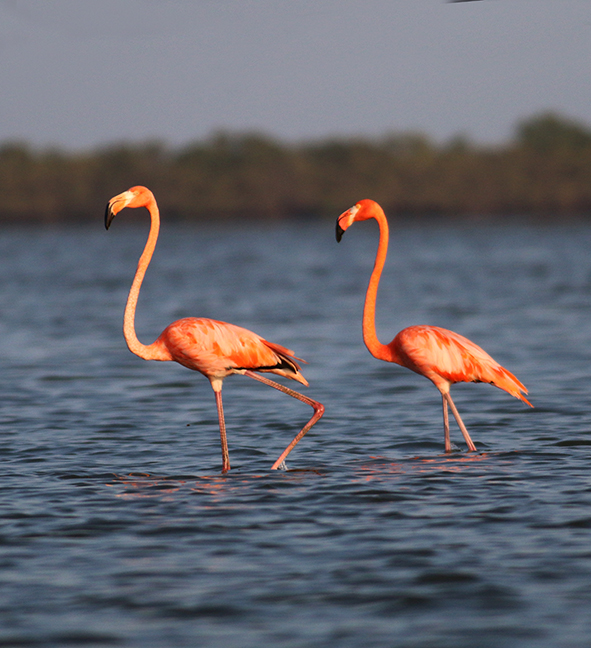
Somehow they just didn’t seem real. ..the combination of bright color, neck length, overall size, and that bizarre bill shape.
After breakfast we set out in search of some of the land birds of the region. And such a nice group of species they were: Green-rumped Parrotlets, Scaled Doves, Slender-billed Inezia, Yellow Orioles, Cattle Tyrants, Vermillion Flycatchers, and Carib Grackles all were in trees adjacent to the dining area. A short drive away we roamed through the brush, finding multiple Orinocan Saltators and Gray Saltators, Vermillion Cardinals with their exaggerated crests, White-whiskered Spinetails, Chestnut Piculets, Russet-throated Puffbirds, White-fringed Antwren, Pileated Finch, Black-crested Antshrike, Venezuelan Flycatcher, Northern Scrub-Flycatcher, and Pale-legged Hornero, among others.
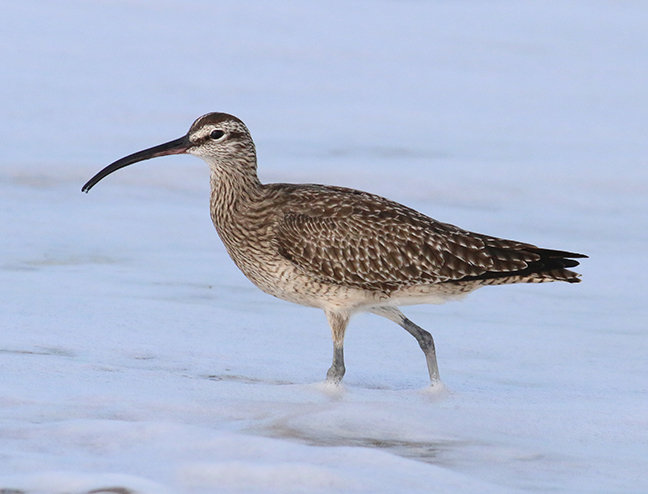
Sure, we see Whimbrels in New Jersey, but this one seemed to glow in the morning light and in the surf.
It was very nice having two days to spend here instead of rushing through in a single day the way most packaged trips to the region do. The lack of any frantic rushing allowed us to walk along the oceanfront one morning, where the locals were ending a night of fishing, dragging in their nets and bringing in some fresh fish and camarones.
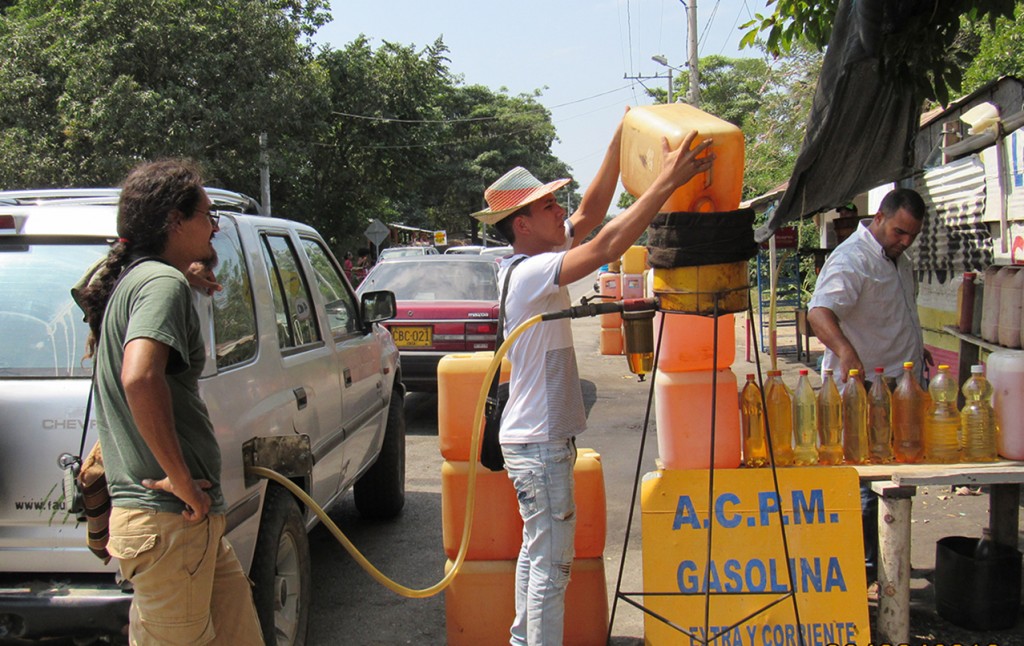
A Colombian ‘gas station’. In villages, they sell gas in plastic bottles or larger drums, then pour it into a container, where it fills the tank by gravity through a small rubber hose.
When we were leaving the region we passed by a small wet area that held White Ibis, Scarlet Ibis, and intermediate color forms. Sebastian described recent studies claiming that Scarlet Ibis is not a separate species, but a color variant of White Ibis. I’ll have to look into that, but it was interesting to see the three color variants side-by-side.
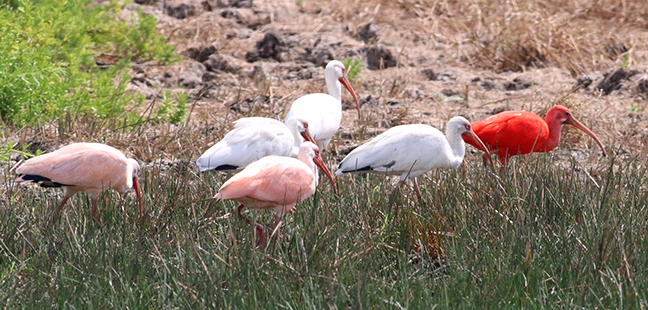
Scarlet Ibis, White Ibis, and….Pink Ibis??? Hybrids? Or just intermediate color morphs? I’ll have to do some reading.
One more Colombian blog: finishing up
The ProAves El Dorado Reserve starts at ~5,700 ft above sea level and extends further up the ridge. In the last entry I described some of the birds that we saw on the way up towards this location; here we’ll cover the upper reaches of the road, starting just below the reserve and working upward. For those who might be traveling here, or who have been here before, this section has a couple landmarks; a short distance down the road from the Reserve at ~5,400 ft there is a small tienda surrounded by lovely flowering bushes called La Tienda de Las Rosas, and about half a mile or so further up the road is the Palo Alto farm/hostel, and then the start of the Reserve. We were scheduled to stay at Palo Alto, but because it is being renovated, we stayed at the tienda, which is a tiny roadside store that has a very sparse adjacent room with 4 bunkbeds. At first we were a bit wary of staying here, since it is not your typical vacation housing, but we had a wonderful time here as guests of Elvira and Tonio in the middle of the forest.
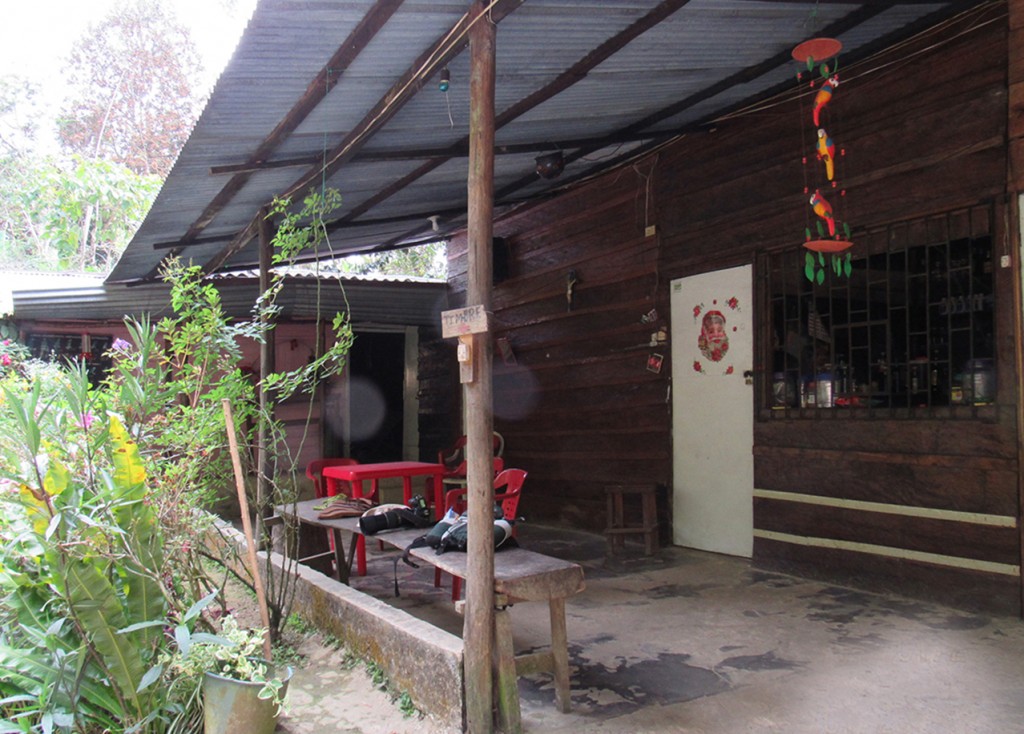
The Tienda de los Rosas, alongside the road to San Lorenzo Ridge. The ‘store’ where they sell cheeses, jams, water, etc. is behind the bars and the door with ‘Papa Noel’. Our room is to the left of Papa Noel.
We stayed here two nights, walking up the road towards Palo Alto and El Dorado Preserve, or downhill. We had the best meals of our trip here, and the front of the tienda was a great place to kick back and watch the humingbirds. Hey, when you’re birding it’s about proximity, not about luxury. The flowers and feeders here are frequented by Green Violetear, Pale-bellied Hermit, Violet-crowned Woodnymph, White-sided Flowerpiercer, Rusty Flowerpiercer, and Blue-naped Chlorophonias. It also draws the occasional endemic Blossomcrown and Santa Marta Woodstar, each of which we saw here and nowhere else. The adjacent forest had guans, Channel-billed Toucanets, Santa Marta Brush-finches, White-lored Warblers, and Montane Foliage-gleaners among the highlights.
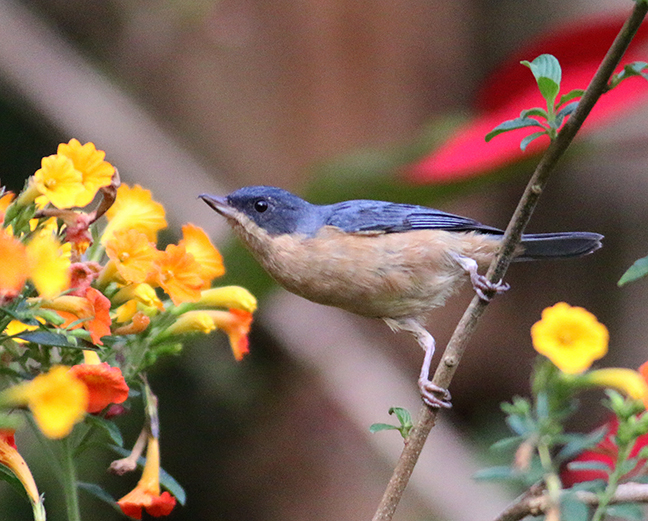
A Rusty Flowerpiercer that was competing with the more numerous White-sided Flowerpiercers by the tienda flowers.
We stayed one night at an even higher elevation (~7,700 ft), by the Telecom tower. Once again this is not your typical tourist stopping point, with a small room that contains four bunkbeds and an adjacent tiny kitchen/dining area where the Telecom employee Leonardo prepared meals for us. The views towards the central part of the Sierra Nevadas was gorgeous, with a few snow-capped peaks visible in the distance. Remember that we are only ~10 degrees north of the equator! This highest part of the San Lorenzo Ridge is ripe with endemics and near-endemics; on a morning walk uphill from here the highlights were Santa Marta Warblers, Santa Marta Mountain-tanagers, Streak-capped and Rusty-headed Spinetails, Brown-rumped Tapaculo, Yellow-crowned Whitestarts, White-tipped Quetzals, and Golden-breasted Fruiteater. All great birds.
We stopped for occasional birding breaks on the way downhill to break up the monotony of the long slow drive, with our next destination being the Los Flamencos Sanctuary in the hot dry coastal Guajira region. On the way to Santuario del Los Flamencos we paused after a toll booth because some birds were perched nearby. While focusing my binocs to view a falcon, the knob of my focusing wheel broke off from the underlying focusing gear. Despite extensive efforts, the bins were useless for the rest of the trip. Luckily Sebastian had an emergency pair of 8x25s with him, so I wasn’t completely up the creek without the proverbial paddle, but from here on I will never go on a birding trip without a pair of backup bins.
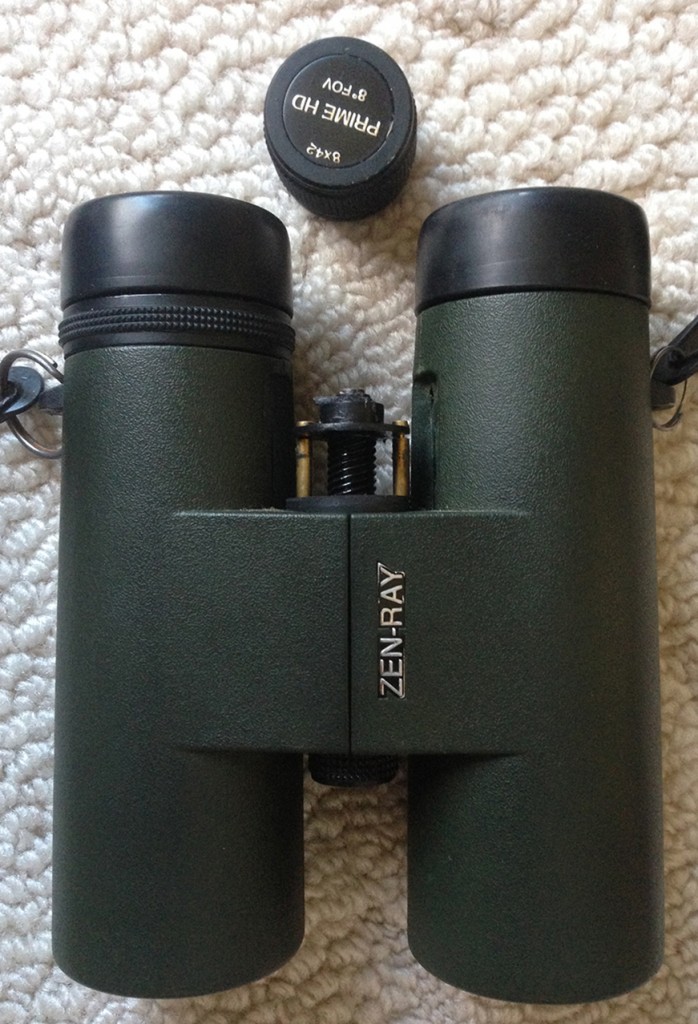
Bins are not very useful unless you can focus them, and these bins couldn’t. Learn from me and always bring a backup pair on vacation. Zen-Ray replaced the bins no-questions-asked within a week of my returning back to the USA.
Next entry: Los Flamencos
The Sierra Nevada mountains of Colombia are renowned in the birding world. The highest peak in this coastal mountain range lies just 28 miles from the Atlantic Ocean, yet rises to a height of 18,950 feet. The Sierra Nevadas are separated from the Andes by a wide valley, resulting in a hotbed for endemic species and a group of near-endemic species that are shared with neighboring Venezuela. The main route to access these endemic species is a road that leads from the small town of Minca (located at ~2,000 ft. elevation) up to Cerro Kennedy (~7,700 ft.) at the top of the San Lorenzo Ridge. Within this relatively short distance it is possible to observe 19 endemic bird species.

Morning view from near the top of the San Lorenzo Ridge. Peaks in the distance had some snow on top.
Before we get to the birds, allow me a few moments to discuss practical matters in case you are considering a trip here. First, it is generous to call the route up to Cerro Kennedy a road; it’s a road in the sense that it’s a wide unvegetated path through the forest, but don’t picture pavement or an even surface. Calling it a dirt road is more accurate but still misleading. It’s certainly the worst road that I have ever been on, requiring 4 wheel drive vehicle, enhanced clearance, a sturdy spine, and driving skills to avoid leaving car parts behind on the protruding rocks. To give you an idea of how rugged it is, near the top of the ridge above El Dorado Lodge we drove nine miles in three hours. That is a grand speed of THREE mph, which is an average human walking pace. Thankfully the road has been freshly paved up to Minca, but beyond Minca the road goes from bad to worse to will-the-vehicle-survive-this-drive. This might sound like exaggeration, but if you are going, be prepared for a rough ride and don’t be fooled by apparent short distances…a mile on that road is not equivalent to a mile on your road at home. Second, because of the road conditions, it is preferable not to travel the road more than is necessary. You certainly don’t want to drive up from Minca to El Dorado or beyond more than once despite their close proximity on a map. There are plenty of hostels in and around Minca, but at higher elevations there are not many places to stay overnight. The El Dorado Lodge currently costs more than $300 per night when rooms in comfortable hostels in Minca can be had for $20 per night, and the ProAves/EcoTurs people who run the lodge were far from cooperative. The Palo Alto hostel located about a mile below El Dorado would be a great affordable choice, but it was being renovated when we were there. So either be prepared to pay the ProAves fees or expect to rough it a bit. Finally, birding in this area is primarily road birding. That’s OK though, because it is a one-way dead-end road, so it doesn’t get much traffic in the higher reaches away from Minca. Motoscooters are the most common mode of travel, often with three family members on them due to the gas mileage and greater ease of maneuvering on the uneven road. Most of your time up here will be spent birding the road.

I don’t have great photos of the rougher sections of the road, but here is a fairly typical section.
Now on to the birds. One of the interesting things about birding this road is following the changes in species as the elevation changes. In the lower reaches, for example, Pale-breasted Thrush was common. As we drove upwards, eventually some Yellow-legged Thrush were observed, only to be replaced by Black-headed Thrushes higher up, and at the highest elevations, Great Thrush replaced the other species. Similar changes occurred in warbler species with Tennessee common near Minca, Blackburnian predominating in mid elevations, and Slate-throated and Yellow-crowned Whitestarts being found near the top. So when planning a trip here it is useful to spend time at the different elevations.
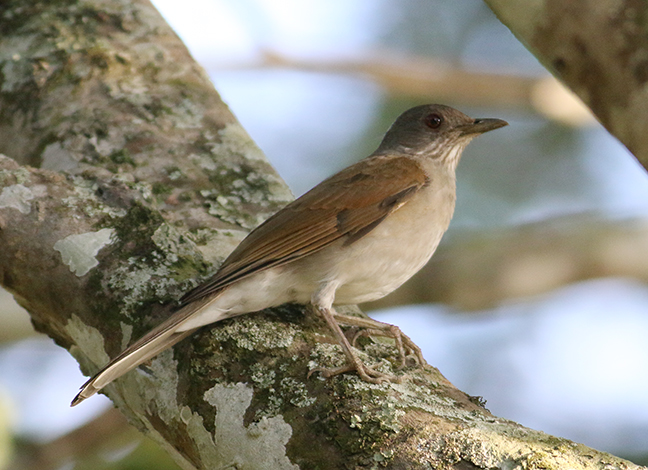
Pale-breasted Thrush, the most common thrush that we saw on this trip, especially at low-to-mid elevations.
Anticipating this distribution, our ‘plan’ was to spend two days each at low, mid, and higher elevations, but due to unexpected changes, we had only a single day of birding at the higher elevations, which is a shame because that is where the tougher endemics dwell. A few endemic species such as Santa Marta Brush-finch can be found at the lower elevations, but the tougher targets are typically found at higher elevations starting a little below the El Dorado Lodge area. If I was going to do this trip again, I would try to spend a night at the Research Station, which is considerably further uphill from the lodge. Still the birding was good. Here I’ll focus on the low-to-mid elevation section, from Minca to just below El Dorado, and in the next blog entry we’ll switch to the area around El Dorado Lodge and upwards.
We didn’t bird much in Minca itself, since our housing at this altitude was outside of town, maybe two miles up the road, at the Hotel Colonial and at the Faunal Nature Reserve. We did stop for lunch at the Minca Hotel, which hosted five hummingbird species at their feeders: Steely-vented and Rufous-tailed Hummingbirds, Black-throated Mango, White-vented Plumeleteer, and White-necked Jacobin.
While birding the road near our base at the Hotel Colonial we spotted a group of species that eventually would become commonplace on this trip: Crimson-backed Tanagers, Swallow Tanagers, Pale-breasted Thrushes, Buff-throated Saltators, Rufous-crowned Warblers, Red-crowned Woodpeckers, White-tipped Doves, and Black-chested Jays, along with some species that were less common for us: Collared Aracari, Whooping Motmot, Barred Antshrike, Keel-billed Toucan, Yellow-bellied Seedeater, White-bearded Manakin, Rufous-and-white Wren, Golden-winged Sparrows, King Vultures, Yellow-backed Orioles, Orange-billed Nightingale-thrush, Gartered Trogon, and Red-legged Honeycreepers, along with many other species.
It has been interesting to see how many of the species that we normally see up in NJ also appear here. The most common ones so far have been plenty of Prothonotary Warblers in the mangroves yesterday, and up here we are seeing good numbers of Tennessee and Blackburnian Warblers, and smaller numbers of Northern Waterthrushes, Black-and-white and Yellow Warblers, Rose-breasted Grosbeaks, and Summer Tanagers.
One morning we went birding with Sebastian on a short trail in Faunal, his small nature reserve located maybe a mile or two uphill from Hotel Colonial. Here we found a number of new species for the trip, including Long-billed Starthroat, Blue-black Grosbeak, Rufous-tailed Jacamar, Lineated Woodpecker, Streaked Saltators, and Gray-headed Tanager. We missed a Little Tinamou that was stalking through the brush and a calling Ferruginous Pygmy-Owl. A presumed Common Potoo was doing feeding runs just after dark when we were trying to locate the Night Monkeys that live on his property. Cool.
One more comment is worth mentioning here. Our trip was not just about birds, but also for relaxation and for interacting with the local people. One day we went swimming at Pozo Azul, a very popular swimming hole in the local river. Tourists are continually walking up from Minca or taking the motoscooter ‘taxis’ up here. It must be a zoo when lots of people are there; we stopped here for a swim late one afternoon when it was fairly quiet.
Another great episode occurred at the Hotel Colonial, where we stayed for two nights and which had hammocks outside of every room. As I was lying in my hammock one afternoon, I heard gorgeous accordion music (no that’s not an oxymoron!) coming from around the corner of the veranda. I walked over, and found Pete with two locals, one of which turned out to be an award-winning Colombian musician. We had fun with them.
Next entry: The El Dorado Reserve area and above.
We birded two sites in the Barranquilla region. Our first stop, the 4km road outside Palermo, was a location that I saw listed in eBird, with many nice species consistently reported. Its a dirt road that extends straight into a marsh with small fincas scattered on both sides. Our hotel arranged for a driver to bring us from Barranquilla and stay with us while we birded along the road for ~3 hrs. It was a mid-afternoon excursion due to our arrival time in Barranquilla, so it wasn’t optimal for birding, but we were anxious to get into the field. This road doesn’t get much use, and I’m not sure what the locals think of visitors, although we didn’t have any problems. As we soon found out, a smile, a wave, and an energetic “Buenos dias! Como esta?” goes a long way to break down barriers anywhere in Colombia. Because it was dry season (and by ‘dry’ I mean ‘dry’…no rain for nearly three months), it wasn’t so easy to find nearby water in the marsh. We did see a few nice species here, like Yellow-chinned Spinetail, White-headed Marsh-tyrant, Limpkin, Striated Heron, and many Snail Kites, and lifers like Scaled Dove, Cattle Tyrant, Russet-throated Puffbird, Bicolored Wren, and lots of distant Bare-faced Ibis. We missed hoped-for Northern Screamer, White-cheeked Pintail, and White-faced Whistling-duck. A scope would have been very useful here, but we didn’t bring one on this trip. Still, it was a nice beginning for our adventure.

Bicolored Wren. We saw…and heard… these guys nearly everywhere on our trip. They are very loud and very vocal.
The next morning we were picked up by Sebastian and brought to Parque Isla Salamanca, a coastal salt water mangrove wetland with a fairly long boardwalk. Our highlights here were a pair of Chestnut Piculets, Pied Puffbird, Common Tody-Flycatcher, Northern Scrub-Flycatcher, Black-crested Antshrike, Red-rumped Woopecker, close views of perched Brown-throated Parakeets, Black-crested Antshrike, the drab Bicolored Conebills, and Straight-billed Woodcreeper. On the non-feathered front we saw a pair of caimans and our first iguana of the trip. We didn’t find the endemic Sapphire-bellied Hummingbird (perhaps due to the lack of many flowering plants) or Chestnut-winged Chachalaca that are often reported here.
In the afternoon we continue our drive about two hours further, past Santa Marta and up towards Minca, where we will spend the next six days exploring locations along the road up to the San Lorenzo Ridge.
The next entry: from Minca to El Dorado
I am not a fan of cold weather, so when winter arrives here in the northeast I love heading to tropical climates to escape the frozen landscape and enjoy some warm weather birding. This year I decided to head to Colombia for the first time. Colombia hosts more bird species than any other country (>1,900 species!), but for many years was underbirded due to security issues. Although the US Department of State still issues warnings about where to go, what to do, and what NOT to do, things have stabilized substantially, and birders and birding tours are returning to Colombia. In the next few posts I will try to relay impressions from my first birding trip to Colombia.
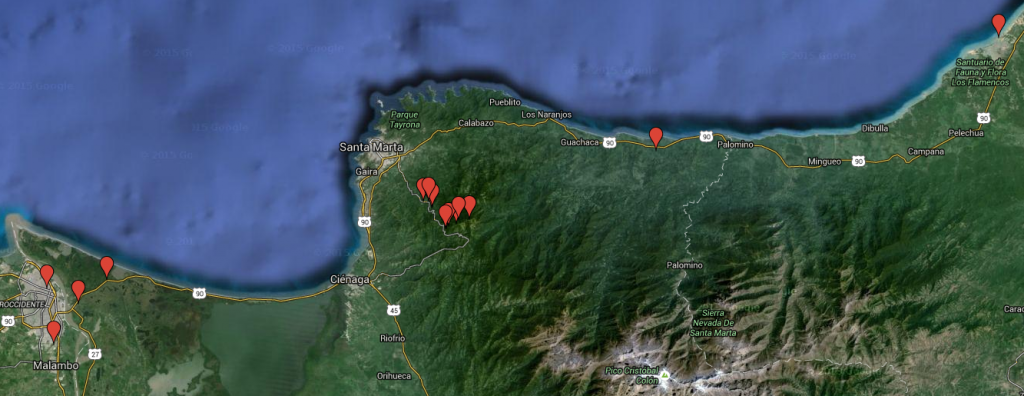
A map of the locations that we visit on this trip. Click on the image to access the Google map and to get details of each tagged location.
But perhaps it would be helpful to begin with some broad information and what we tried to do. To get a sense of perspective, Colombia is a relatively large country, slightly larger than Texas and California combined, and 4x as large as Ecuador. In addition, it is bisected by three arms of the northern Andes (the eastern, western, and central cordilleras) each separated by wide valleys, and also contains coastline on both the Pacific and Atlantic Oceans, expansive high plains (the Llanos), Amazonian lowlands, and the world’s highest coastal mountain range (the Sierra Nevada range) that is separate from the Andes. This size and geographical diversity results in biological diversity, but also creates difficulty for visitors who try to cover too much territory in too little time. So how does a birder cover all that terrain? The big name commercial birding tours that focus on maximum species numbers try to sample much of the country in a single tour, usually over a two-to-three week time frame, with lots of travel time interspersed with relatively short birding stops. That exhausting and frantic pace is not my kind of birding. So instead, my friend Pete and I decided to cover a relatively small area at a more leisurely pace, focusing on the coastal Sierra Nevada range. Commercial birding tours often offer this region as a six day extension, but we decided to cover the same area in a more leisurely twelve day time frame. We contacted Sebastian Ballesteros, a local freelance birder/guide/photographer who along with his brother David runs a small hostel and nature preserve called Faunal, located a few short miles above the town of Minca. Sebastian agreed to guide us for about half of the days and to leave us to bird by ourselves on the other days, resulting in a nice combination of guided and solo birding. Sebastian speaks English very well, which was a great help for two Americans who speak muy poquito Spanish, and provided excellent service. Our version of the ‘Santa Marta extension’ begins in Barranquilla on the Atlantic coast, we’ll spend nearly a week at different altitudes proceeding along the long rugged rocky road that climbs up from Minca to the San Lorenzo Ridge in pursuit of Santa Marta endemics, we’ll return back to the coast to bird in the dry scrub of the Guajira region, and then return for a few relaxing days in low dry forest and a final afternoon in Bogota.
Today we left behind the massive storm that delivered ~22 inches of snow to NJ a few days ago. The timing was fortunate, since there was enough time to clear away the snow and the backlog of flights, and our flights were not delayed. We caught some sleep during a long layover in the Bogota airport, and arrived in sunny Barranquilla ready for some tropical birding.
Next post: Let the birding begin.
